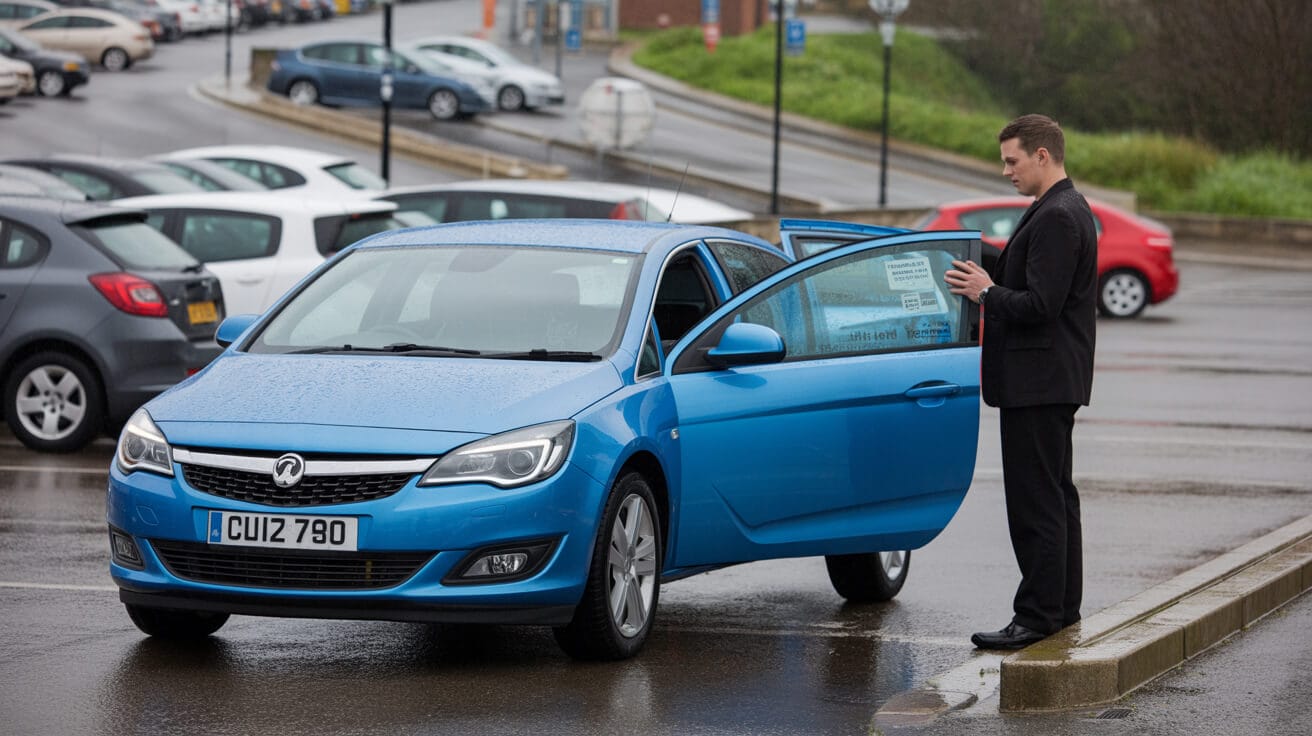Why does your car key refuse to turn—and how do you get moving safely?
When your car key won’t turn in the ignition, your next move holds more weight than you think. For drivers across the UK, this isn’t just a minor annoyance—it’s a red flag that demands measured action. Too many people try to force the issue or trust old internet hacks, risking broken keys, spiralling repair costs, or insurance confusion that can haunt you later. The smartest thing you can do is slow down and verify: are you lawfully allowed to act on the vehicle, and have you checked the basics? Setting up a clear path for diagnosis and resolution isn’t just wise—it’s a requirement for protecting your car and your claim.
Modern UK ignition systems blend mechanical, electrical, and legal checks. Rushing or improvising skips the smart path, risking not just mechanical failure but compliance headaches. Observing the details—like warning lights, unexpected noises, recent DIY work, or battery changes—gives you and your technician everything needed for a first-time fix.
Trust starts when every detail of your car’s problem is noticed, not ignored.
Should you try to turn the key or wait for help?
If your key won’t turn, don’t force it. Step one: look for obvious blockages in the ignition barrel or on the key itself. Gently check the steering wheel (most UK cars use it to lock the system when powered off). Avoid unnecessary pressure—twisting a stuck key is a fast way to snap it or damage the lock. Take note if the problem hit after heavy rain, car bumps, or using a backup key. This context, especially in UK vehicles with advanced anti-theft, sets the stage for the best possible repair.
The importance of owner verification and initial checks
Never see owner verification as a hassle—it’s the shield for your insurance and repair rights. Reliable companies (think Autolocks Ltd) will always check your authority before getting to work. Start by inspecting the key for grime, wear, or warping. Test remote locking: if central locking works, your key might be fine and the trouble is deeper. Note any warning lights (especially dash icons) or new vehicle quirks. Always use original or manufacturer-approved spare keys; fakes bring hidden headaches.
What common UK faults make keys stick—and how can you check them fast?

Most ignition failures in UK cars come from well-known triggers. Knowing where to look, and what’s fast to check, can keep panic and costs low while ensuring your fix actually sticks. Quick fixes rarely solve big problems, but smart observation avoids wasted money and unnecessary downtime.
Five smart checks are worth more than a dozen guesses—prevention is better (and far cheaper) than panic repairs.
What physical or environmental factors stop a key turning?
Key and ignition wear are classic offenders—models like HU66 (VW group), HU101 (Ford), NSN14 (Nissan), and TOY43 (Toyota) often see blade or cylinder fatigue. Winter brings moisture and salt, taking out door harness grommets or causing cylinders to stick. Using the wrong lube (read your handbook!) can gum things up. Bending or wearing out a key blade makes for rough, risky inserts—always change a tired key before you’re stuck. Deadlocks, splash corrosion, or cold snaps freeze mechanisms—if the dashboard throws immobiliser lights, think electronic, not just physical, trouble.
DIY checks to isolate the real cause
- Look for debris or scoring in the barrel and on the key.
- Double-check your key matches your car’s make and year—mismatched cuts are more common than you’d think.
- Look for worn or bent blades (they rarely seat clean).
- Test door function and watch for harness snags at grommets, especially after storms.
- Recall your timeline: did the problem follow battery swaps or wild weather?
- Confirm child locks and deadlocks aren’t trapping you—they’re simple but widely overlooked.
Careful five-minute checks could save you a 90-minute callout or unnecessary ignition replacements.
How do electronic locks and UK immobilisers complicate things?

The most stubborn ignition failures today don’t come from keys—they stem from networks of electronics and immobiliser systems. Newer models raise the bar for both security and complexity, changing what causes trouble and how you solve it.
Missing the digital handshake wastes hours—a professional scan reveals what guesswork never will.
What’s behind immobiliser, transponder, and electronic failures?
Modern cars (especially post-2005) run an approval line: keys embed chips (ID48, ID46, 4D, 47_AE, Toyota 70/80-bit) that must “handshake” via low-frequency (LF, 125 kHz) waves to the car’s brain (immobiliser module). If your fob battery is weak, the handshake won’t register—a classic fault. If any module (Electronic Steering Lock, Body Control Module, or Gateway) misses a check, your engine stays silent no matter how perfect your key feels. Urban radio interference (shops, condos, even buses) and software glitches in keyless/phone-based entry block you, too. Scans, not trial-and-error, pinpoint the trouble.
How to validate the issue before escalation
- Request full-spectrum diagnostic checks—mechanical, electronic, and network layers.
- If power is in doubt, swap the car battery or fob battery first.
- Note LED or dashboard code changes during attempts.
- Confirm digital key setups (BLE/NFC/UWB) are correct; try re-pairing if in doubt.
- Get a compliance-ready job report before approving any module, fob, or coding replacement.
Thorough documentation streamlines later repairs and protects your insurance stance.
Can DIY fixes make ignition problems worse or void your insurance?

It’s tempting to reach for basic tools when you’re stuck. Yet with ignition and immobiliser systems, unauthorised fiddling or forceful moves often backfire—costing you more than the original repair, and sometimes wiping your insurance protections entirely.
Unauthorised fixes create hidden costs—your best protection is proof, credentials, and records.
What risks come with DIY or non-accredited interventions?
Anything resembling drilling, picking, or “brute force” work kills your insurance and warranty instantly, unless it’s logged, traced, and authorised. UK standards (and most OEMs) allow only certified technicians, using traceable keys and genuine tools. Using ghost keys or cloned fobs not listed by the carmaker might work temporarily, but risks dashboard warnings, lockouts, or future programme denials. Swapping modules or steering locks without correct programming spawns “phantoms” (errors that won’t trace cleanly), wasting both time and money. Cheap tools often neglect data privacy, opening up GDPR and claim risks.
How to know where to draw the line
- Reject destructive work or visible tool marks.
- Check all IDs—every legit tech must show credentials and log repair steps.
- Keep receipts, written job notes, and your own digital proof (photos).
- Demand that every tool is authorised and traceable to a legal supplier.
- Don’t settle for “invisible” or no-warranty fixes.
Your best defence is meticulous evidence—against future disputes or denied coverage.
What should you expect to pay—and how do you avoid hidden costs or poor coverage?

Ignition or immobiliser fixes can run from quick fixes to complex, multi-module jobs. Cost control starts with transparent pricing and clear, written documentation.
Your best payment is traceable, itemised, and linked to warranty—clarity is worth more than discounts.
How transparent pricing and advance documentation protect your wallet
A simple check and barrel clean in the UK starts around £85; digital immobiliser or key module programming can reach £320 or more. Expect after-hour and emergency multipliers, always fixed up front. Honest locksmiths—like Autolocks Ltd—provide itemised quotes (labour, parts, callout), plain-English warranty details, and use payment tools that tie every penny to your job. Card, invoice, and PO payments anchor your protection; cash, especially unlogged, weakens your claims.
Fleet and business jobs get extra rewards with asset-linked digital tracking and loyalty pricing. Leading firms plug their records straight into your asset management, reducing risk and unlocking future savings.
Critical cost-control steps for all clients
- Only approve written, itemised estimates.
- Read and keep warranty details (start/end dates up front).
- Don’t allow jobs without asset ID or VIN logging.
- Check review platforms for real NPS/CSAT scores, not just star ratings.
- Pay officially; trace every payment, always.
- Ask about loyalty discounts or fleet benefits before confirming the job.
These steps keep your bills predictable and your claims robust, now and next time.
What GDPR, documentation, and audit practices must your service meet in 2025?

Today, an ignition fix is only as good as its documentation and GDPR compliance. Your data is as sensitive as your key. Proper practice in 2025 means your car’s storey and your identity stay protected before, during, and after the repair.
A clean audit trail protects your car, your claim, and your data rights—never accept anything less.
How does modern compliance and documentation affect work on your car?
Expect every step of your job to be digitally logged—name, date, time, tool, and outcome—right down to the signature and the photo proof. GDPR rules require that logs are encrypted and that nobody beyond essential staff can access your data. Companies must redact unneeded info, explain their retention policies, and disclose credentials on request. Autolocks Ltd, for example, uses audit-ready job platforms and photo logs tied to VINs, asset IDs, and electronic handovers—giving you both compliance and proof.
Losing track of these details compromises not just your data, but your insurance and even resale value.
Key compliance checks for peace of mind
- Receive signed, date/time-stamped job records for every transaction.
- Require repairs to map to a VIN or asset for traceability.
- Read and accept GDPR/data retention policies up front.
- View and verify all accreditations—never just take anyone’s word for it.
- Only allow access to logs by staff who need to know.
- Insist on aftercare and supporting paperwork every time.
Auditable records and transparent practices are the dividing line between safe and sorry.
How do leading UK locksmiths ensure superior service, aftercare, and social proof?

The fix is only the first step. Premium UK auto locksmiths distinguish themselves with airtight intake, proven methods, visible aftercare, and ongoing customer service that breeds trust long after the engine starts.
Reputation is built with every handover, visible proof, and answered call—service is a cycle, not a single step.
What should you expect from best-practice service delivery and aftercare?
From the first handshake, expect thorough ID collection, signed consents, and up-front explanation of work steps. The job is always photo-logged and serialised against your asset ID. After the fix, you’ll see working locks, alarms, and ignition demonstrated—techs don’t leave until you do. Aftercare tips (custom for your car and habits) reduce the chance of you needing a callout soon after.
Leaders encourage visible feedback, open up their NPS/CSAT metrics, and give real escalation options if something isn’t right. Reviews are encouraged, not hidden, and job records flow naturally into warranty and insurance proof.
If you need to follow up, great firms hand you real contact links—not just a “job done” text.
Checkpoints for a frictionless, proven experience
- All prework steps (consent, scope) are visible and signed.
- Always attend the demo—see what works with your own eyes.
- Collect your tailored aftercare sheet after handover.
- Give verified feedback; see that it feeds into provider scores.
- Double-check for live, real escalation routes before you’re left alone.
Genuine aftercare means being a valued client, not a receipt number—built for the long run.
Why book with Autolocks Ltd—what does the process guarantee for you?

When you choose Autolocks Ltd, you’re buying bulletproof access, not just a fix. Everything they do is traceable, compliant, and built to last—taking the stress out of every step.
When it matters—choose transparent process, documented results, and true peace of mind.
What does a booking with Autolocks Ltd actually involve?
Every job starts with owner ID checks and a compliance-driven intake. Each action is signed, photo-logged, and tied to VIN and asset IDs. No tool or process is used unless the paperwork and your consent is fully in place. The tech walks you through the diagnosis, the fix, the test, and the handover—on your timeline. You get everything in writing: outcome, aftercare, and warranty, all anchored in GDPR-redacted logs.
Fleet and business clients get records plugged right into asset platforms, matched to contracted SLAs. Solo drivers benefit from the same level of aftercare plus live support, proactive contact, and service that remembers not just your car, but your worries and constraints.
How do these safeguards deliver real advantages?
- No work ever starts without ID and sign-off—it’s your protection as well as theirs.
- All fixes are non-destructive by default, with certified techs every time.
- Full digital logs and handover paperwork bolster warranty and insurance claims for years.
- Fleet repairs map directly to business records and compliance regimes.
- Ongoing aftercare, support lines, and escalation guarantee quick responses, not runarounds.
- Satisfaction and performance systems mean every question gets an answer.
Choose Autolocks Ltd when you want ignition access that’s compliant, cool-headed, and proven at every point. If you value trustworthy process, detailed outcomes, and ongoing support, our services are ready for your next journey.
Frequently Asked Questions
What concrete actions should you take first if your car key won’t turn in the ignition?
You need to prove you have ownership or clear authorization before attempting anything—UK locksmith rules and insurance require it, and missing this step causes far more trouble later. Next, thoroughly check your key: even small bends or buildup can jam the lock, so never force it. Try both main and spare keys; aftermarket spares often highlight hidden faults. If your key moves freely in the locks but won’t turn in the ignition, test if the remote can still lock or unlock the doors. If the remote works, suspect a mechanical issue in the ignition; if not, you may have an electronic or immobiliser fault. Always make a note of recent events—bumps, spills, extreme weather, or child interventions are often the missing context a locksmith needs to spot the root cause.
“Miss the legal step and you risk three times the hassle—because repair without proof can leave you out in the rain without a claim.”
Initial Response Checklist
- Secure proof of ownership or dealer/fleet consent.
- Check the key’s blade and bow for bending or grime.
- Test both main and spare keys before any further action.
- Note remote function versus ignition behaviour—problem type often separates here.
- Document any recent impacts or unusual events; let these be your memory when speaking to a technician.
Autolocks Ltd requests ID and authorization at the start, ensuring each step is documented and legally compliant, so your repair path remains safe and provable.
How do small mechanical or environmental issues spark bigger ignition problems?
The vast majority of stubborn UK ignition faults arise from small, often overlooked physical issues—blade wear, pocket grit, or rainy weather. Keys for popular models (like HU66 for VAG, HU101 for Ford, TOY43/NSN14 for Toyota/Nissan) develop tip or shoulder wear that a glance misses, but a cylinder feels instantly. Incorrect lubricants such as oil or graphite can gum up modern locks—only use the brand-approved spray. Door wiring can fail where the harness crosses the grommet, especially after wet weather or long use, leading to silent disconnects that mimic ignition faults. During cold spells, both key and lock contract; force at this moment can deform the system. Instead, warm the key in your hand and insert gently. Finally, if warning lights flash or the car doesn’t “see” the key, these are real problems—don’t ignore them.
“A gritty key means bigger trouble is building under the surface—you can’t wish it away with force.”
Mechanical & Environment Watchpoints
- Use only approved lube for cleaning the lock.
- Inspect the key blade—especially if it’s an older style or sees daily use.
- Examine the door harness at the grommet for wear or corrosion.
- In cold or damp, warm the key gently; never heat with a flame.
- Treat any strange dash light as a technical flag—not cosmetic.
Autolocks Ltd’s process always starts non-destructive and trim-safe, protecting not just your ignition but your warranty and future value.
What hidden electronic or programming failures prevent the key from working?
Modern UK vehicles have immobilisers—the key must answer an invisible “challenge” signal, and if the chip is mismatched, weak, or not recognised, turning gets blocked long before the engine even considers starting. Issues vary: some cars use rolling code remotes, others need LF 125kHz transponders to handshake correctly, and all must agree across key, steering column, and BCM/software modules. ESL (electronic steering lock) faults can jam up the entire starting chain even if the key is perfect. Nearby retail doors, parking lot masts, or radio interference can block the wireless signal required for key authorization. Programming mistakes swell when unapproved buyers use cheap phone apps to clone or add keys—the result is usually a lockout or immobiliser fault that only proper scan tools (not phone gadgets) can reveal and fix. Finally, digital or app-based keys may break if pairing fails or phone software isn’t updated. After any key coding, mechanical swap, or module update, always demand an audit-stamped report—without it, you have no comeback.
“The key looks fine, but software and chip handshake failures are the silent barrier—the mechanic’s logbook is your only roadmap.”
Technical Validation Steps
- Have only authorised, traceable technicians programme or code keys.
- Request a scan for handshake/module errors, not just surface faults.
- Rule out digital key/app failures: confirm up-to-date devices and successful pairing.
- Secure a signed, time-stamped record after any new component or software action.
Autolocks Ltd’s compliance and logging procedures ensure every fix is traceable, valid for insurance, and ready for the next resale—don’t accept less.
Where is the line between DIY fixes and professional intervention with car ignition?
If you find yourself about to use brute force—picking, drilling, or “banging” the ignition—put the tool down. UK vehicles after 2003 are protected by law (SIA, ISO 26262/21434 standards), blocking non-authorised repair and making destructive access a route to refused insurance and extended costs. DIY programming from online kits or mobile apps is the fastest way to corrupt your immobiliser and shut down future keys. Even if you swap out the ignition switch, newer vehicles demand digital adaptation—miss one module and the car won’t recognise it. Essential every time: keep photo proof, serial numbers, and labour logs for warranty, fleet, or insurance—without them, every claim is just “your word” against the dealer. Always check for SIA/ISO/MLA approval: if a provider cannot show these or explain their documented process, find a better one.
DIY Danger Zones
- Never use destructive force—voiding insurance is the starting penalty.
- Use only authorised, logged coding/programming hardware.
- Every module swap must be paired with digital compliance, not just the mechanical fit.
- Get proof for every action; log it or risk being left out in the cold on claims.
Autolocks Ltd’s expert-led, audit-logged, SIA-approved workflow locks down your legal, financial, and mechanical protection at every stage.
How should you evaluate costs and legal paperwork before green-lighting ignition repair?
Before your technician opens the dashboard, demand a clear, itemised, written quote—UK prices often start near £85 for basic fixes but rise to £320+ for electronic or module-based jobs. Insist on warranty and aftercare specifics linked directly to your car’s VIN; this is crucial for future insurer needs and proof for resale disputes. Remember, emergency or after-hours service costs more; secure all rates and timeframes in writing in advance. Fleets/leaseholders must ensure every report, invoice, and handoff record links vehicles by VIN and asset number—renewals and claims depend on clarity. Always pay via certified method (card/contactless/PO), never cash; digital payments create a traceable evidence string. Repeat or business users should always ask for loyalty, fleet, or package deals—these are normal in the trade.
Cost & Paperwork Safeguards
- Receive and review a written, line-by-line quote and warranty terms.
- Confirm all rates (including after-hours) and SLA in writing before work begins.
- For fleet/lease: verify asset ID and VIN in every job record.
- Demand payment options that produce a formal receipt—protection for you.
- Ask about value-added packages for bulk or loyal customers.
Autolocks Ltd’s transparent pricing, documentation, and customer asset tracking ensures you always have legal and commercial leverage, even years after service.
Why are traceable logs, compliance paperwork, and aftercare vital for your long-term security?
A modern ignition repair or key provision is bigger than a mechanical fix—it’s a fully traceable digital event. Every replacement, coding, or module update produces a timestamped tech record embedded with the SIA/MLA credentials required in the UK. Dealers, fleets, and even savvy private owners expect photo logs and written confirmation that non-destructive-first practice was followed—this lets you win disputes, speed up claims, and protect your resale. GDPR demands careful redaction of personal data, but don’t accept weak logs; security and compliance must remain granular. If your provider can’t produce compliance badges and audit-logs, don’t stake your insurance or reputation on them.
“A traceable record isn’t an extra—it’s the legal scaffolding that keeps the cost, and the argument, off you down the line.”
Long-Term Protection Path
- Secure a digital, technician-certified record for every key, fob, or immobiliser action.
- Request photographic evidence and chain-of-custody logs for all work.
- Confirm asset/VIN linkage and non-destructive-first methods in every report for fleets.
- Insist on GDPR-appropriate but rigorous log retention.
- Reject any provider who can’t prove credentials and audit trail.
With Autolocks Ltd, your repairs and upgrades are always logged, certified, and ready to withstand scrutiny—owner or fleet, today and tomorrow.






